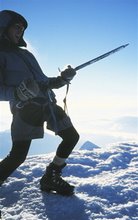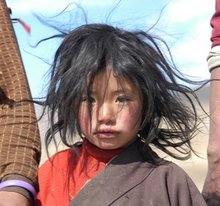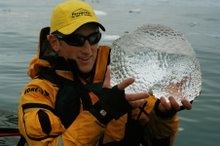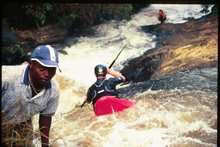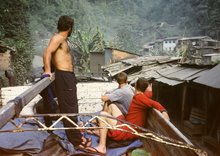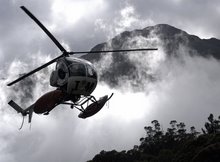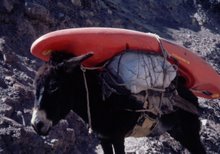
Doesn't every team scout like this? The most western catchment in Arunachal Pradesh is that of the Namjang. Its a big tributary of the Towang Chu. We took a morning to rest after our climb out of the Towang Chu, drank buckets loads of sweet chai and planned our next move.
 Team scout, we take it pretty seriously.
Team scout, we take it pretty seriously.
The Namjang looks awesome if you have these two images painting the picture. We looked at it for a full day before paddling a short section close to the road. The lower gorge was calculated as being steeper than the Towang (not what we wanted) and yet most of our scouting from high above revealed a big lower canyon, lots of flat water, some easy stuff and several obvious portages where the river went ballistic.

Indian wilderness, Super scenic, Andy Phillips on the Namjang.
Image - Zak Shaw
 Time was running low. Whilst we had been paddling the Namjang, Sangrup had hitched a ride back to Tawang to pick up a fax. Our permit was due to expire and before heading back east we needed a ten day extension.
Time was running low. Whilst we had been paddling the Namjang, Sangrup had hitched a ride back to Tawang to pick up a fax. Our permit was due to expire and before heading back east we needed a ten day extension.We drove all night back up and over Se La, the summit pass road before dropping back into the Dirang drainage. That afternoon we quickly packed our kayaks and set off down the Tenga river. The Tenga gorge is 14km long before it joins the Dirang.
We had no real idea of what the gorge would contain. We estimated an average gradient of 20m/km but got a bit nervous when after three kilometres the small creek we were on slotted up into a bedrock box canyon.
 Image - Leaving camp at the start of day 2. We all felt like the day would be great or it would be a massive hike out back to the put in, its just had that feel about it. As it turned out the whole gorge was tight and constricted but it dropped consistently creating some great rapids and clean drops. Around every smooth water-worn corner we waited for a big chocked up boulder jumble but it never came.
Image - Leaving camp at the start of day 2. We all felt like the day would be great or it would be a massive hike out back to the put in, its just had that feel about it. As it turned out the whole gorge was tight and constricted but it dropped consistently creating some great rapids and clean drops. Around every smooth water-worn corner we waited for a big chocked up boulder jumble but it never came.
Image - Mikey Abbott gets a gets out and away off one of the many classic drops in the Tenga gorge.
 Image - Camp 2 Tenga.
Image - Camp 2 Tenga. Image - More of the good stuff above the Dirang/ Tenga confluence. Sam Hughes and Al Ellard get amongst it.
Image - More of the good stuff above the Dirang/ Tenga confluence. Sam Hughes and Al Ellard get amongst it.At about lunchtime on day three we found the Dirang river and more water. It was great, one of the things we had talked about with the trip prior to starting was that it would change dramatically in size once the two big rivers joined.
We stopped for a huge feed of roti, rice, chai, beer, pork fat and dhal in a small village mid afternoon before floating down to camp. (Ah the beauties of rural asia!)

Image - Dramatic lighting on the Kameng River Day 4.
Day four we paddled 45km from the Dirang/Kameng confluence to a town called Bhalukpong.
It was an awesome last day, packed with big volume class 4 whitewater and huge surfwaves.
My last day on the river in India was a good one but hadn't quite finished when Shalab whilst loading kayaks onto the roof racks of the truck slipped and managed to get his leg caught in the bull bars of the truck. He fell with his leg trapped to the ground and snapped his Tibia, the noise was brutal. Our celebrations of a great trip were suddenly postponed as we splinted Shalab's leg, loaded the truck and drove to Tezpur and an Airforce base three hours away.
Zak Shaw

































 Image Zak Shaw - Tehri Dam
Image Zak Shaw - Tehri Dam 



 Whilst paddling downriver we waved at locals and some smart looking officials in uniform. I thought nothing of it.
Whilst paddling downriver we waved at locals and some smart looking officials in uniform. I thought nothing of it.
 With maximum fines a potential court hearing and two month imprisonment over our heads we continued on with the interrogation and finally walked away with a fine of 20,000 rupees/ $500 US. This is the average annual income in India.
With maximum fines a potential court hearing and two month imprisonment over our heads we continued on with the interrogation and finally walked away with a fine of 20,000 rupees/ $500 US. This is the average annual income in India.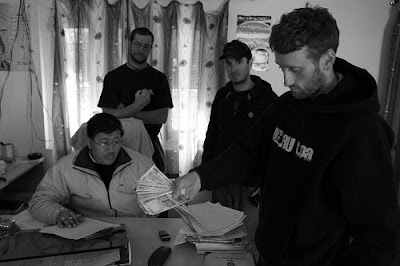 "Making the payment" Lovely doing business with you sir. Image Sam Hughes.
"Making the payment" Lovely doing business with you sir. Image Sam Hughes.































